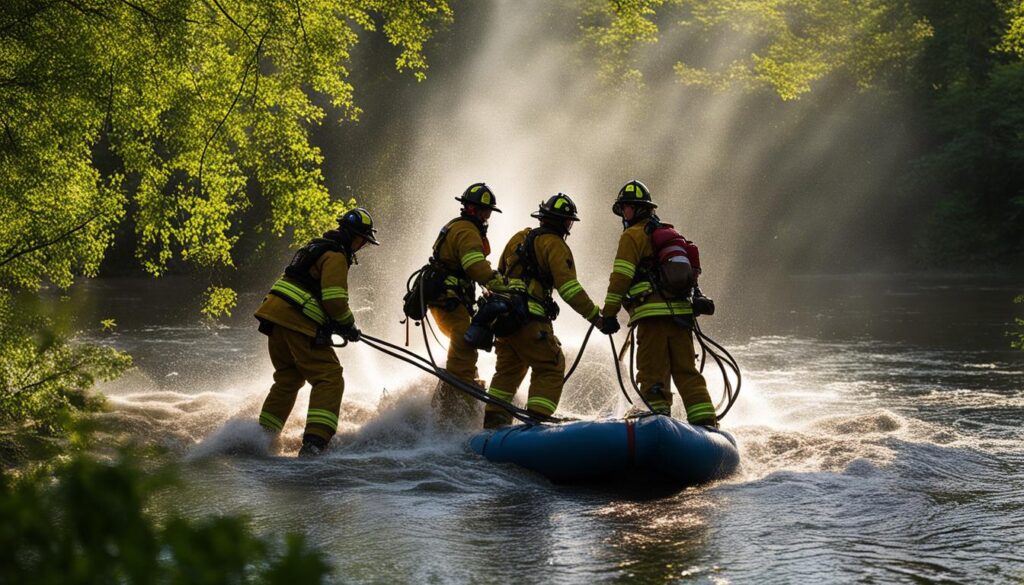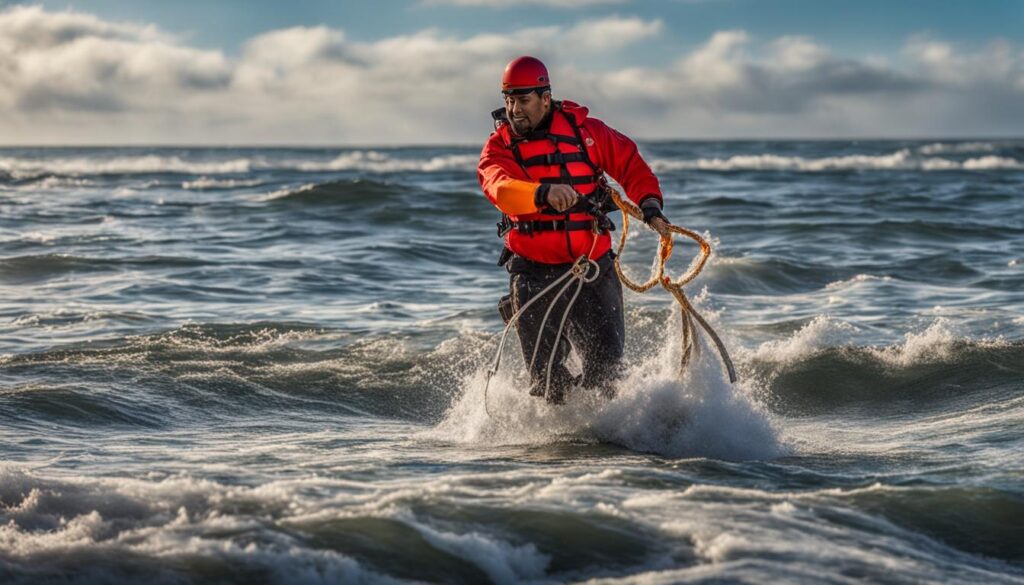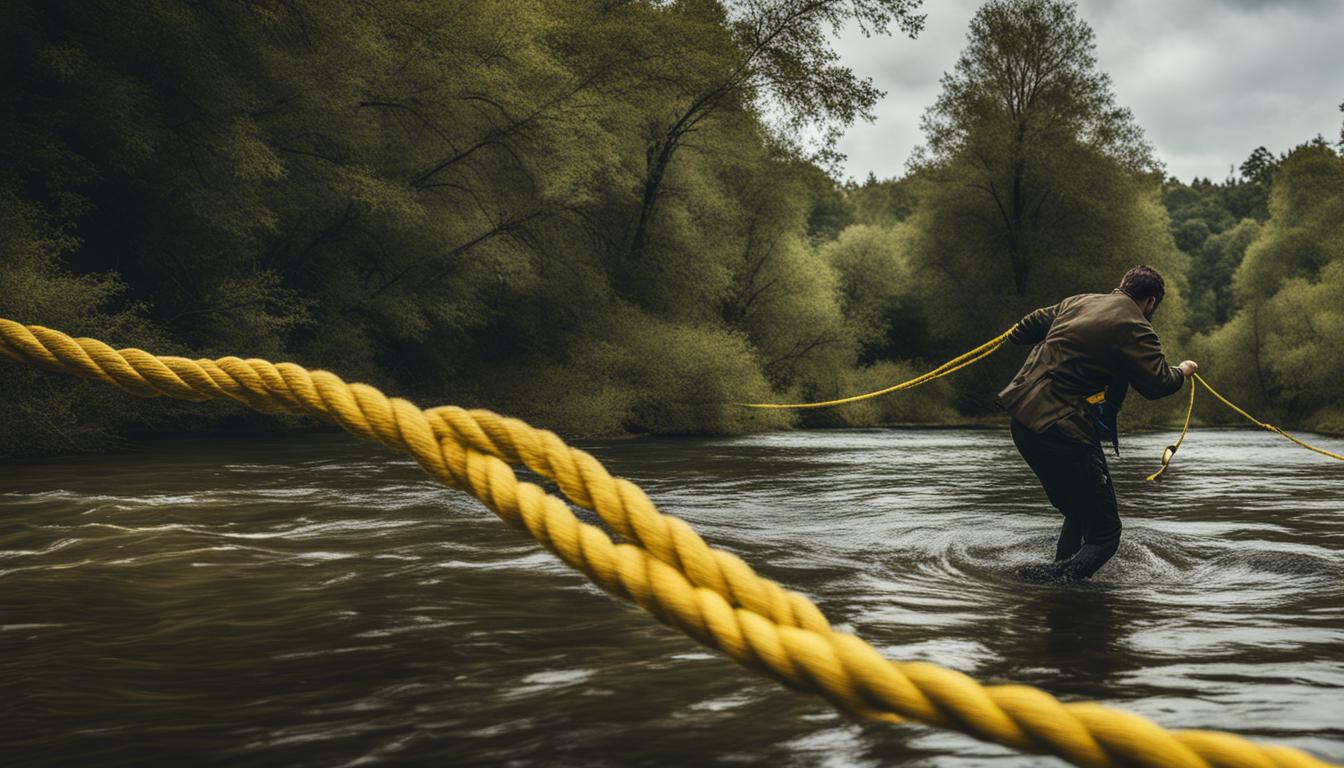In emergency situations, having the proper knowledge and technique for using throw ropes can mean the difference between life and death. Whether you’re a first responder, firefighter, or coastal rower, understanding the importance of throw rope use and mastering the relevant techniques is crucial for effective rescue operations.
When it comes to water rescues, throw ropes are an essential tool that can be easily deployed by emergency responders. Stored in rope bags with floatation devices, these ropes provide both visibility and a lifeline for victims in distress. By practicing and training in proper throw rope techniques, you can increase your chances of success and save lives.
Key Takeaways:
- Throw ropes are critical tools for water rescue and should be practiced and trained with regularly.
- Rope bags with floatation devices aid in visibility and the victim’s ability to grab onto the rope.
- Proper deployment involves dispersing the rope freely and avoiding wrapping it around the hand or wrist.
- Aim to throw the rope in front of the victim, allowing them to grab hold and be pulled to safety.
- Train on recoiling the rope for a second throw if needed.
The Importance of Throw Rope Training for Firefighters
Firefighters play a critical role in emergency response, and their ability to effectively use throw ropes can make a significant impact in water rescue scenarios. The deployment of throw ropes under highly stressful and time-sensitive situations requires proper training and practice. By honing their skills, firefighters can ensure swift and successful rescues, safeguarding both victims and responders.
During training sessions, firefighters learn how to utilize throw ropes stored in rope bags that are often attached to their fire apparatus. These bags typically contain 50 to 75 feet of nylon rope with floatation devices, providing increased visibility and aiding victims in grabbing hold of the rope. When deploying the throw rope, firefighters must open the bag, grasp the rope in their nondominant hand, step on the end of the rope to anchor it, and throw the bag in front of the victim. It is crucial for firefighters to avoid wrapping the rope around their hand or wrist, which can impede the rescue process.
Additionally, firefighters should undergo training to master the technique of recoiling the rope quickly after the initial throw. This allows for a rapid second throw if needed, ensuring that rescue efforts are not delayed. By regularly practicing these skills, firefighters can maintain their proficiency in throw rope deployment, even under the stress and pressure of real-life emergency situations.
With comprehensive throw rope training, firefighters are better equipped to handle water rescue scenarios. Their ability to quickly and accurately deploy throw ropes can greatly improve the chances of a successful rescue, providing a lifeline to those in need. By investing in ongoing training and practice, firefighters can enhance their effectiveness as first responders and save lives.

Table: Essential Elements of Throw Rope Training for Firefighters
| Training Element | Description |
|---|---|
| Proper Rope Bag Handling | Training on how to open and close rope bags, ensuring ropes are easily accessible and stored securely. |
| Effective Throw Techniques | Instruction on proper throwing techniques, such as the underhand throw or side arm throw, to maximize accuracy and distance. |
| Rope Recoiling | Practice recoiling the rope quickly after deployment, enabling rapid second throws if necessary. |
| Realistic Simulations | Engaging in realistic scenarios to simulate high-stress situations and improve decision-making and coordination. |
| Ongoing Refresher Training | Regularly conducting refresher training sessions to reinforce skills and ensure readiness for water rescue emergencies. |
Throw Rope Techniques for Coastal Rowers
Coastal rowers understand the importance of preparedness and quick response in emergency situations. One vital tool that can assist in rescue efforts is the throw rope. These ropes should be easily accessible in times of crisis and stored in convenient locations on the boat or in designated storage areas. This ensures that rowers can quickly retrieve and deploy the throw rope when needed. Additionally, storing the throw ropes in rope bags with floatation devices enhances their visibility, allowing victims to easily locate and grab onto the rope.
When using a throw rope, rowers should establish eye contact with the person in need and maintain a firm stance within the boat. There are two common throwing techniques that rowers can employ – the underhand throw and the side arm throw. The underhand throw involves fully opening the rope bag, grasping the end of the rope, and swinging the bag forward with the release point at eye level. This technique allows for precise aiming and control. The side arm throw involves holding the bag in the outstretched hand to the side of the body and swinging the arm back before sharply throwing it forward. Rowers should practice these techniques to gain proficiency and accuracy in rescue situations.
Throw Rope Techniques for Coastal Rowers
| Technique | Description |
|---|---|
| Underhand Throw | Open the rope bag fully, grasp the end of the rope, and swing the bag forward with the release point at eye level. |
| Side Arm Throw | Hold the rope bag in the outstretched hand to the side of the body, swing the arm back, and sharply throw it forward. |
In summary, coastal rowers can greatly benefit from having throw ropes readily accessible and employing effective throwing techniques. By practicing and mastering these techniques, rowers can increase the chances of successful rescues in emergency situations. Remember to prioritize safety at all times and regularly review and update training protocols to ensure preparedness.
Choosing the Right Throw Bag for Water Rescue
In emergency situations, having a quick-release throw rope can mean the difference between life and death. When selecting a throw bag for water rescue, there are several factors to consider to ensure its effectiveness. The construction and strength of the rope are crucial. It should be made of synthetic materials that float, such as polypropylene, with a minimum diameter of 7mm and a maximum diameter of 9.5mm. The minimum breaking strength of the rope should be 13,000 N.
Another important factor to consider is the length of the rope. The length can vary depending on the needs of the rescue, but for boat-based rescues, a minimum length of 35 feet is recommended, while shore-based rescues may require a length of 50 feet. It is important to have enough rope to reach the victim and allow for proper rescue techniques.
Additionally, the throw bag should be properly prepared for quick deployment. The loop tied in the end of the rope should be removed and replaced with a small figure 8 on a bight tied with a loop large enough to accept a carabiner. This ensures that the rope can be easily attached to a rescue device or the victim. Finally, the rope should be properly packed in the bag without any knots or entanglements that would hinder its deployment.
| Key Factors | Recommendations |
|---|---|
| Rope Construction | Synthetic materials that float, minimum diameter of 7mm, maximum diameter of 9.5mm |
| Rope Strength | Minimum breaking strength of 13,000 N |
| Rope Length | Minimum of 35 feet for boat-based rescues, 50 feet for shore-based rescues |
| Bag Preparation | Loop replaced with a small figure 8 on a bight, no knots or entanglements |

By considering these factors and selecting the right throw bag, you can ensure that you are well-prepared for water rescue situations. Remember, quick deployment and ease of use are crucial when every second counts. Properly storing and maintaining your throw bag is also important to ensure its effectiveness in an emergency. Regularly check and replace any worn or damaged ropes, and keep the bag easily accessible in your water rescue kit.
Techniques for Throwing a Rescue Rope
When it comes to rescue situations, throwing a rope accurately can mean the difference between life and death. Whether you’re a firefighter, a coastal rower, or an emergency responder, mastering the art of rope throwing is essential. In this section, we’ll explore two primary techniques for throwing a rescue rope: the underhand throw and the side arm throw.
The underhand throw is a classic technique that offers balance and accuracy. To execute this technique, start by fully opening the rope bag and grasping the end of the rope. With your throwing hand near your eye level, swing the bag forward and release the rope, aiming for your target. Practice and repetition are key to developing your throwing accuracy with the underhand technique.
The side arm throw is another effective method for throwing a rescue rope. Begin by opening the rope bag and holding the end of the rope in your hand. Extend your arm to the side of your body, then swing it back and sharply forward, releasing the bag as your throwing hand aligns with the front of your body. The side arm throw is particularly useful in scenarios where you need to quickly deploy the rope with precision.
Remember, proper training and practice are essential for honing your rope throwing skills. By mastering these techniques, you’ll be better equipped to navigate emergency situations and assist those in need.
Best Practices for Using a Throw Bag in Different Rescue Scenarios
When it comes to using a throw bag in different rescue scenarios, there are certain best practices that can significantly increase the effectiveness of the rescue operation. Whether you are dealing with moving water rescues or ice rescues, understanding the specific techniques and considerations for each scenario is crucial. Here are some important tips to keep in mind:
1. Moving Water Rescues
In moving water rescues, it is important to position yourself on the upstream side of the rope to prevent being swept downstream. By doing this, you can maintain control and avoid potential entanglements. Additionally, it is recommended to avoid fully wrapping the rope around yourself, as this may compromise your ability to move quickly and safely. Coaching the victim to lay on their back and hold the rope over the opposite shoulder can help increase the speed and efficiency of the rescue.
2. Ice Rescues
In ice rescues, throwing the throw bag directly over the victim can be a useful technique. By coaching the victim to wrap the rope around their arm, they can maintain contact with the rope and prevent it from slipping away. This ensures a stronger connection and enhances the chances of a successful rescue. However, it is important to exercise caution and follow proper safety protocols when approaching ice rescues, as the ice may be unstable and pose additional risks.
3. Rope Retrieval Techniques and Knots
In emergency situations, time is of the essence, and being able to retrieve the throw rope quickly and efficiently is crucial. Practice various rope retrieval techniques to ensure you can swiftly bring the rope back to you for subsequent throws or to secure it to a stationary object for stability. Additionally, familiarize yourself with different knot tying methods that are suitable for emergency use, such as the figure-eight knot or the bowline knot. These knots provide reliable strength and can be quickly tied and untied when needed.
By following these best practices and continually honing your skills through training and practice, you can effectively utilize throw bags in different rescue scenarios. Remember, safety should always be the top priority, and it is essential to coordinate and communicate with your team members to ensure a coordinated and successful rescue operation.
| Best Practices: |
|---|
| – Position yourself upstream in moving water rescues to maintain control |
| – Avoid fully wrapping the rope around yourself in moving water rescues |
| – Coach the victim to hold the rope over the opposite shoulder in moving water rescues |
| – Throw the throw bag directly over the victim in ice rescues |
| – Coach the victim to wrap the rope around their arm in ice rescues |
| – Practice rope retrieval techniques for quick and efficient rescues |
| – Familiarize yourself with different knot tying methods for emergency use |
Conclusion
In emergency situations, throw ropes play a crucial role in water rescues. Whether you are a firefighter, a coastal rower, or a first responder, proper training and practice are vital for effective throw rope use. The ability to handle throw ropes under stress is a skill that can make a significant difference in rescue outcomes.
Accessibility of throw ropes in times of crisis is also of utmost importance. Being able to quickly and easily access the throw ropes can save valuable time during an emergency. Ensuring that throw ropes are stored in easily accessible locations, such as on boats or in designated storage areas, can make a big difference in rescue effectiveness.
Remember, choosing the right throw bag and mastering throwing techniques are essential for successful throw rope deployment. Regularly reviewing and updating training protocols is crucial in maintaining proficiency. By prioritizing safety and continuously honing your skills, you can be better prepared to handle emergency situations and increase the likelihood of a successful rescue.
FAQ
What is the importance of throw rope training for emergency responders?
Throw rope training is crucial for emergency responders to ensure they can effectively deploy throw ropes in rescue situations.
How should throw ropes be stored for quick deployment?
Throw ropes should be stored in rope bags with floatation devices for increased visibility and ease of grabbing.
What are the two primary throwing techniques for a rescue rope?
The two primary throwing techniques are the underhand throw and the side arm throw.
How should throw ropes be selected for water rescue?
Throw ropes should be made of synthetic materials that float and have a minimum diameter of 7mm and a maximum diameter of 9.5mm.
What are the best practices for using a throw bag in different rescue scenarios?
In different rescue scenarios, such as moving water or ice rescues, specific techniques and coaching methods should be employed to ensure successful rescue operations.





